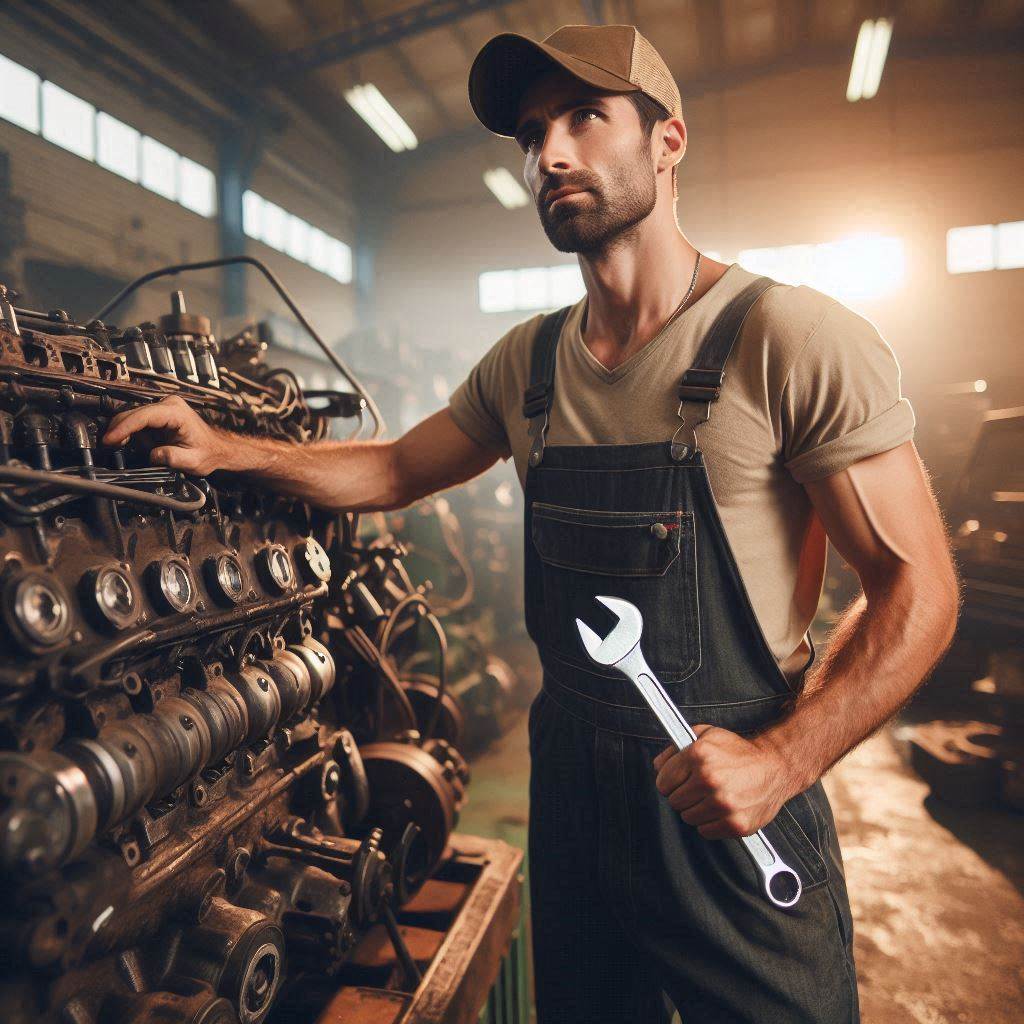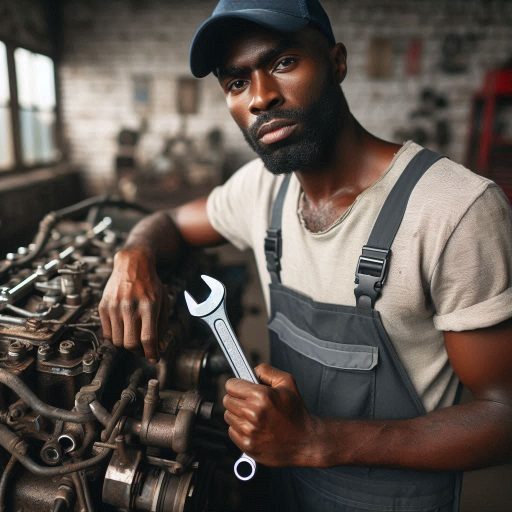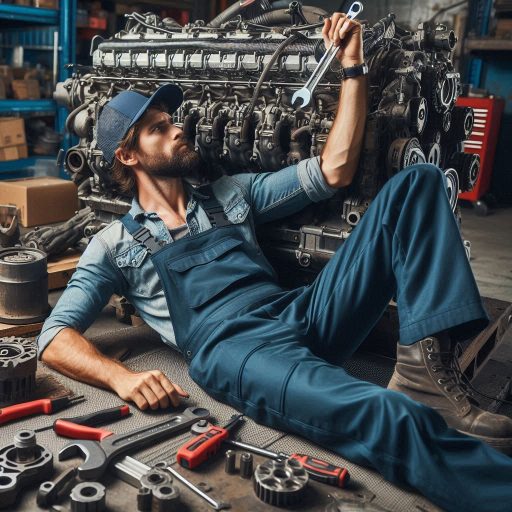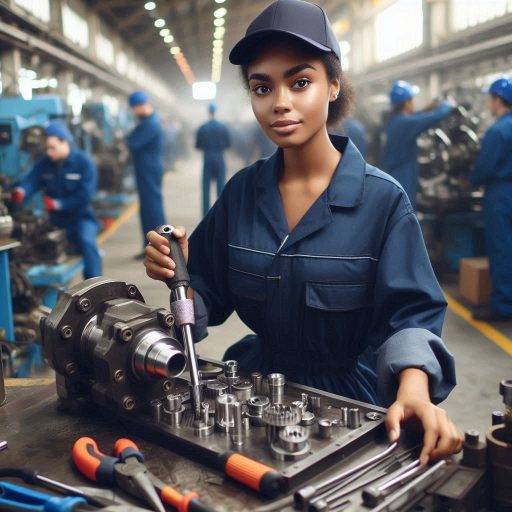Introduction
Industrial mechanics play a crucial role in maintaining equipment and machinery in various industries.
It is important for professionals in this field to keep up with emerging technologies.
Understanding the Digital Transformation
One of the key aspects of emerging technologies in industrial mechanics is the digital transformation.
This involves the integration of digital tools and systems to improve efficiency and productivity.
Advancements in Automation
Industrial mechanics have witnessed significant advancements in automation technologies.
This includes the use of robotics and artificial intelligence to streamline processes.
Enhanced Monitoring and Maintenance
New technologies have enabled better monitoring and maintenance of equipment.
Predictive maintenance tools can help prevent breakdowns and reduce downtime.
Improved Safety Standards
Emerging technologies in industrial mechanics also focus on enhancing safety standards.
Features such as sensors and remote monitoring help in creating a safer work environment.
Training and Skills Development
Professionals in industrial mechanics need to constantly upgrade their skills.
Training programs on emerging technologies ensure they are equipped to handle modern equipment.
Overall, staying updated with emerging technologies in industrial mechanics is essential for the growth and efficiency of industries.
Overview of Industrial Mechanics
Definition of Industrial Mechanics
Industrial mechanics refer to professionals who maintain and repair machinery in various industrial settings.
They are skilled technicians who ensure that equipment and systems operate smoothly.
Roles and Responsibilities of Industrial Mechanics
Industrial mechanics play a crucial role in ensuring that machinery and equipment are functioning efficiently.
Their responsibilities include troubleshooting, repairing, and performing preventative maintenance on machines.
Importance of Industrial Mechanics in Various Industries
Industrial mechanics are essential in industries such as manufacturing, construction, automotive, and aerospace.
They help to minimize downtime, increase productivity, and ensure the safety of workers.
Evolving Technologies in Industrial Mechanics
Use of Internet of Things (IoT) in Machinery Monitoring
Industrial mechanics are leveraging IoT technology to monitor equipment in real-time.
This enables them to detect potential issues before they lead to costly breakdowns, enhancing overall efficiency.
Advancements in Predictive Maintenance through Machine Learning
Machine learning algorithms analyze data to predict when machinery may require maintenance.
This proactive approach helps industrial mechanics schedule repairs before major problems occur, saving time and resources.
Integration of Robotics and Automation in Industrial Processes
Robotics and automation are transforming industrial mechanics’ roles by handling repetitive tasks and improving accuracy.
Mechanics now work alongside robots to enhance productivity and precision in manufacturing and assembly processes.
Implementation of Augmented Reality for Troubleshooting and Training
Augmented reality (AR) technology allows industrial mechanics to visualize complex machinery and access step-by-step instructions for repairs.
AR enhances training programs and speeds up troubleshooting, reducing downtime and improving efficiency.
Transform Your Career Today
Unlock a personalized career strategy that drives real results. Get tailored advice and a roadmap designed just for you.
Start NowRead: CAD Technician vs. Draftsman: Key Differences
Importance of emerging technologies in industrial mechanics
Emerging technologies play a crucial role in enhancing efficiency and productivity in the field of industrial mechanics.
By staying abreast of the latest advancements, professionals can streamline operations and stay competitive in today’s rapidly evolving landscape.
How emerging technologies can improve efficiency and productivity
- Automation: Automation systems can help optimize processes, reduce manual labor, and minimize errors in industrial settings.
- IoT integration: The Internet of Things allows for real-time monitoring and data analysis, enabling predictive maintenance and improved decision-making.
- Augmented reality: AR technologies can provide technicians with interactive guides and remote assistance, speeding up troubleshooting and repairs.
Impact of technology on traditional mechanics practices
- Shift towards digitalization: Traditional methods are being replaced by digital tools and software that offer enhanced capabilities and insights.
- Increased precision: Emerging technologies enable precise measurements and control, leading to higher accuracy in repair and maintenance tasks.
- Enhanced safety: Advanced systems can help identify potential hazards and prevent accidents, ensuring a safer working environment.
Examples of emerging technologies in the field
- 3D printing: Additive manufacturing is revolutionizing prototyping and parts production, reducing lead times and costs.
- Remote monitoring: IoT sensors and cloud platforms allow for remote monitoring of equipment performance, enabling predictive maintenance strategies.
- Machine learning: ML algorithms can analyze vast amounts of data to identify patterns and optimize processes in industrial machinery.
Overall, embracing emerging technologies is essential for industrial mechanics to stay competitive, improve operational efficiency, and adapt to the changing demands of the industry.
Read: CAD Technician Certification: What You Need to Know
Artificial intelligence (AI) in industrial mechanics
Predictive maintenance using AI
AI is transforming industrial maintenance by predicting equipment failures before they occur.
AI analyzes data from sensors to identify patterns that indicate potential issues.
This proactive approach helps prevent costly downtime and allows for efficient scheduling of maintenance.
Benefits of using AI in industrial mechanics
Improved equipment reliability and uptime due to predictive maintenance.
Reduction in maintenance costs as issues are addressed before they become major problems.
Enhanced safety for workers as AI can identify potential safety hazards in advance.
Increase in overall efficiency and productivity of industrial operations.
Challenges and limitations of implementing AI in the field
Initial high cost of implementing AI technology and infrastructure.
Complexity of integrating AI systems with existing industrial machinery and processes.
Need for specialized training and expertise to effectively utilize AI in maintenance practices.
Concerns about data security and privacy when using AI to collect and analyze sensitive information.
Overall, AI is revolutionizing industrial mechanics by enabling predictive maintenance and improving operational efficiency.
While there are challenges to implementing AI, the benefits it offers make it a valuable investment for industries looking to stay competitive in today’s technological landscape.
Read: Essential Skills for CAD Technicians

Internet of Things (IoT) in Industrial Mechanics
Internet of Things (IoT) has revolutionized the industrial mechanics sector by enabling the collection and analysis of data in real-time, leading to more efficient operations and maintenance processes.
With IoT devices integrated into industrial machinery, manufacturers can now predict when maintenance is required based on the data collected.
This predictive maintenance approach helps in preventing unplanned downtime and reduces maintenance costs significantly.
How IoT devices can collect and analyze data in real-time
IoT devices are equipped with sensors that gather data on various parameters such as temperature, pressure, vibration, and energy consumption.
This data is then transmitted to a central system where it is analyzed in real-time.
Showcase Your Business Today
Reach thousands of readers actively exploring professional services. Publish your business profile and grow your audience now.
Publish NowBy continuously monitoring the performance of industrial equipment, manufacturers can detect anomalies and potential failures before they occur.
This proactive approach to maintenance enhances the overall reliability and efficiency of the machinery.
Integration of IoT in industrial machinery for predictive maintenance
By leveraging IoT technology, manufacturers can implement predictive maintenance strategies that are based on the actual condition of the equipment rather than a predetermined schedule.
This condition-based maintenance approach ensures optimal performance and extends the lifespan of the machinery.
IoT enables the implementation of smart sensors that can detect changes in equipment performance and notify maintenance personnel when intervention is required.
This real-time monitoring allows for timely maintenance actions to be taken, preventing costly breakdowns.
Examples of IoT applications in industrial mechanics
- Remote monitoring: IoT devices enable manufacturers to monitor the performance of machinery remotely, allowing for quick diagnosis of issues without the need for on-site inspections.
- Asset tracking: IoT technology can be used to track the location and status of industrial assets, ensuring efficient utilization and preventing loss or theft.
- Energy management: IoT devices help industrial facilities optimize energy consumption by providing real-time data on usage patterns and identifying areas for improvement.
In a nutshell, the integration of IoT in industrial mechanics offers numerous benefits such as improved maintenance practices, enhanced equipment performance, and increased operational efficiency.
As this technology continues to evolve, we can expect even more innovative applications that will further transform the industrial sector.
Read: Day in the Life of a CAD Technician
You Might Also Like: Top Companies for Field Service Technician Jobs
Delve into the Subject: Best States for Surveying and Mapping Technicians
You Might Also Like: Networking Tips for Geotechnical Engineers
Robotics in industrial mechanics
In the realm of industrial mechanics, robotics plays a crucial role in revolutionizing the way tasks are automated within industrial settings.
Role of robots in automating routine tasks in industrial settings
Robots are increasingly being utilized to carry out monotonous and repetitive tasks in industrial environments, freeing up human workers for more complex and strategic activities.
Tasks such as material handling, assembly, and inspection can be efficiently performed by robots, ensuring precision and consistency in the production process.
Benefits of using robotics in industrial maintenance
The integration of robotics in industrial maintenance brings forth numerous benefits, including increased productivity, improved safety, and reduced downtime.
Robotic systems can conduct predictive maintenance, detect anomalies, and perform repairs in hazardous environments without risking human lives.
Furthermore, robots can operate 24/7, enhancing the overall efficiency of maintenance activities and reducing operational costs in the long run.
Challenges and considerations when implementing robotics in the field
Despite the advantages of robotics in industrial mechanics, there exist challenges and considerations that need to be addressed when implementing robotic systems.
One of the main challenges is the high initial investment required for acquiring and integrating robotic technology into existing workflows.
Moreover, the technical complexity of programming and maintaining robots may pose a challenge for organizations lacking the necessary expertise or resources.
Another consideration is the need for adequate training for human workers to collaboratively work with robots, ensuring a smooth transition and optimal utilization of the technology.
Additionally, safety protocols and regulations must be established to protect human workers and prevent accidents or mishaps involving robotic systems.
In review, robotics is a game-changer in industrial mechanics, offering unparalleled efficiency, precision, and safety in automating routine tasks and maintenance activities within industrial settings.
Virtual Reality (VR) and Augmented Reality (AR) in industrial mechanics
Training and Simulation with VR and AR
Virtual Reality and Augmented Reality have revolutionized the way industrial mechanics are trained and prepared for real-life scenarios.
VR and AR technology provide a fully immersive experience that allows workers to simulate maintenance tasks in a controlled environment.
With VR, mechanics can practice various maintenance procedures on virtual equipment before handling them in the actual workplace.
This helps in familiarizing workers with complex machinery and reduces the risk of errors or accidents during maintenance tasks.
AR, on the other hand, overlays digital information onto the physical world, providing real-time guidance and instructions during maintenance activities.
Benefits of VR and AR in Improving Safety and Efficiency
One of the key advantages of using VR and AR in industrial mechanics is the improvement in safety standards.
By allowing workers to practice maintenance procedures in a virtual environment, the risk of accidents and injuries is significantly reduced.
Workers can make mistakes and learn from them without any real-world consequences.
Additionally, VR and AR technology enhances the efficiency of maintenance tasks by providing workers with real-time data, instructions, and problem-solving assistance.
This helps in minimizing downtime and improving productivity in industrial settings.
The interactive nature of VR and AR also promotes better engagement and retention of information among workers.
Future Potential of VR and AR in the Field
The potential of Virtual Reality and Augmented Reality in industrial mechanics is vast and promising.
As technology continues to advance, VR and AR applications are expected to become more sophisticated and integrated into everyday maintenance processes.
Companies are investing in developing custom VR and AR solutions tailored to their specific maintenance needs.
In the future, VR and AR could be used for remote assistance, allowing off-site experts to guide on-site workers through complex maintenance procedures.
This can lead to faster problem resolution and reduced travel costs for technical experts.
Furthermore, the use of VR and AR can also result in cost savings by optimizing maintenance processes and reducing errors.
Overall, Virtual Reality and Augmented Reality have already begun to revolutionize the field of industrial mechanics by providing innovative training solutions and improving safety and efficiency in maintenance tasks.
With continued advancements in technology, the future looks bright for VR and AR in the industrial maintenance sector.
Discover More: Exploring IT Support Specialist Internship Programs
Conclusion
Emerging Technologies in Industrial Mechanics
Keeping up with emerging technologies in industrial mechanics is crucial for staying relevant in the field.
Industrial mechanics play a vital role in maintaining and repairing complex machinery.
Advancements in technologies such as IoT, robotics, and automation have revolutionized the industrial sector.
These innovations have made processes more efficient and optimized productivity.
Industrial mechanics need to adapt to these changes by learning new skills and staying updated on the latest trends.
Continuous training and education are essential to stay competitive in the industry.
IoT technology allows for real-time monitoring and predictive maintenance of equipment, reducing downtime and improving safety.
This has significantly enhanced the efficiency of industrial operations.
Additionally, robotics and automation technologies have automated repetitive tasks, increasing productivity and accuracy.
Industrial mechanics who embrace these technologies can work more efficiently and effectively.
Furthermore, staying informed about emerging technologies is essential for industrial mechanics to remain competitive and successful in their careers.
Embracing new technologies can lead to career advancement and improved job opportunities in the industrial sector.
In closing, it is essential for industrial mechanics to keep up with emerging technologies to stay competitive.
Embracing new technologies can lead to career advancement and success in the industrial sector.
[E-Books for Sale]
The Big Book of 500 High-Paying Jobs in America: Unlock Your Earning Potential
$19.99 • 500 High-Paying Jobs • 330 pages
Explore 500 high-paying jobs in America and learn how to boost your career, earn more, and achieve success!
See All 500 High-Paying Jobs of this E-Book
1001 Professions Without a Degree: High-Paying American Jobs You Can Start Now
$19.99 • 1001 Professions Without a Degree • 174 pages
Discover 1001 high-paying jobs without a degree! Unlock career tips, skills, and success strategies for just $19.99!




